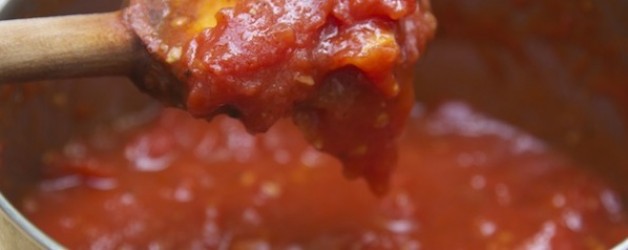There’s a lot to be said for the fantastic flavor of a great tomato. When they are in season, or when you find a variety you like in the grocery store, it is tempting just to eat the tomato as is. More often than not, however, tomatoes found in the store out of season just don’t measure up. Of course, there are recipes or dishes where fresh tomatoes are a must (salads, guacamole, etcetera), but when you need some good tomato flavor in a cooked dish, canned tomatoes are the way to go. Tomatoes are picked and canned at their peak, so they retain great flavor. Just as we choose different types of tomatoes for various reasons, there are different types of canned tomatoes to consider depending on how you plan to use them.
Fresh Tomatoes
Types. The basic types of tomatoes found in grocery stores are: round or globe; beefsteak (usually larger with irregular shapes); plum or Roma (oblong shape and usually fleshier varieties, so good for using in sauces and cooking); vine-ripened (supposedly have better flavor since they are allowed to ripen on the vine); grape (small Romas); cherry (small and round).
Storing tomatoes. Tomatoes are best stored at room temperature. They should not be refrigerated since it affects flavor and texture.
Seeding. The easiest way to seed a tomato (this helps reduce the water content when you use the tomato in a dish) is to cut it in half and squeeze out the seeds. Sometimes you can use either your fingers or a spoon to brush out the seeds.
Peeling. Often when cooking with fresh tomatoes, it is best to peel them. If you don’t, then you will have bits of the tougher outer skin floating around in a dish, or giving it an unpleasant texture. Here’s the easiest way to remove the skin from a tomato: cut an “x” at the smooth end of the tomato, drop into boiling water for about 20-30 seconds. Transfer to a bowl of cold (preferably ice) water. The skin should peel off easily as you pull at the cut end.
Freezing. You can freeze tomatoes. It will affect their texture though, so you only want to use tomatoes you have frozen in cooked dishes. If you are going to freeze, we think it is best to freeze them already peeled. Stewed tomatoes or tomato sauces also freeze really well.
Canned Tomatoes
Since there are several types of canned tomatoes available, we wanted to mention them here, but our preference (unless specifically stated in a recipe) is to buy whole, peeled tomatoes, because the best tomatoes are kept whole and canned. Usually diced, crushed, and pureed tomatoes are not the finest of the crop. We recommend Muir Glen or San Marzano. One (14.5oz) can of tomatoes is the equivalent of about 2 cups chopped tomato.
Types. Whole, peeled; diced/crushed (convenient, but definitely a difference in texture); pureed (cooked and strained); sauce (different than jarred spaghetti sauces available in stores, canned tomato sauce is also cooked and strained like pureed tomatoes, but thinner and used as a base for lots of dishes); paste* (concentrated tomato flavor from tomatoes that have been cooked a long time. Use small amounts to give a more intense tomato flavor. Can be found in tubes as well since you usually only use a small measurements at a time, although the tubes are more expensive for that convenience).
Freezing. *Freezing tomato paste is a great way to use any left over in the can. Just measure out 1 teaspoon scoops onto a baking sheet, freeze, then put into a plastic bag once solid. You can also use an ice tray).
Basic Recipe for a Quick, Delicious Marinara
- 1 (28-ounce) can of whole, peeled tomatoes (You can chop the tomatoes, or just use your hands or a spoon to break down, or crush, the tomatoes when you add them to the pan.)
- 2 tablespoons olive oil
- 4 cloves garlic
- 1 to 2 teaspoons salt
- 1 teaspoon black pepper
- 2 teaspoons sugar (optional)
1. Crush garlic cloves and sauté in oil for about a minute, being careful not to burn them.
2. Add the can of tomatoes, and simmer for 15 to 20 minutes.
3. Add salt, pepper, and sugar, if using (taste the sauce before adding sugar and add if you want to balance out some of the acidity). Simmer another 5 minutes.
Variation: Add about 4 tablespoons of coarsely chopped basil at the end.



